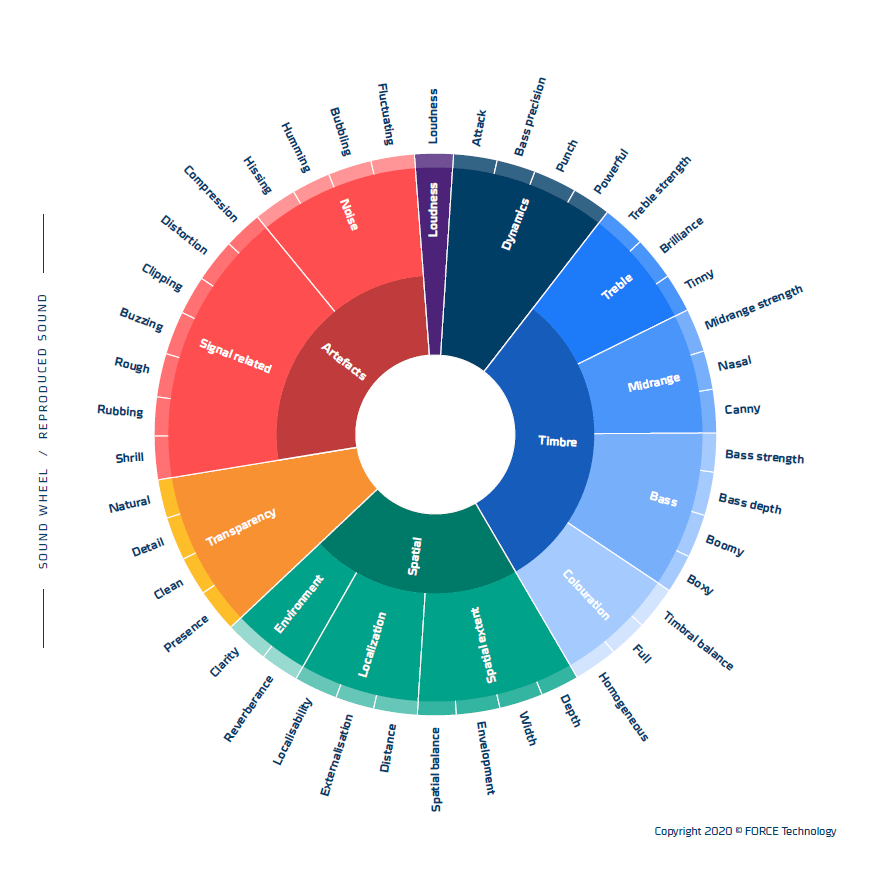
How Phonak Engineers are ‘sound connoisseurs’
Engineers at Phonak use a sound wheel to understand what sound attributes are needed to produce the best sounding hearing aids, much like coffee connoisseurs use a flavor wheel to brew the best tasting coffee. Learn more in this blog article by 3 Phonak sound connoisseurs.
What words would you use to describe your morning coffee? Strong? Weak? Milky?
Did you know that there are 110 officially recognized words to describe coffee? The Coffee Taster’s Flavor Wheel was published in 1995 by the Specialty Coffee Association* to provide a standardized set of vocabulary for coffee industry professionals. The use of the wheel is not to judge if a coffee is good or bad but to support professionals and connoisseurs in describing the aroma and flavor of coffee.
What about sounds? What words would you use to describe the sound of running water? Or the rustling of paper? How do audiological engineers describe different types of sounds, sound environments or even artefacts?
This article introduces the basic vocabulary of sound quality and how sound engineers at Phonak use a sound wheel to improve the sound quality attributes of our hearing aids.
Need for a common language
Effective communication needs a common language. Effective communication also profits from razor-sharp definitions, as it allows us to look beyond first impressions. For example, you might take a mental note of coffee shops that you like and those you don’t. But it is the fine distinctions in flavor that crown your favorite cup of coffee.
Just as your coffee can taste sweet, sour, or stale, a sound can be described as boomy, boxy, or buzzing. And just as you can train your taste buds to distinguish finer flavors, you can exercise your ears to extract finer characteristics of sound.
To keep the hearing industry on the same page, standardized lexicons and a sound wheel have been developed to organize sound attributes.
How a sound wheel helps us to understand sound attributes
FORCE Technology, SenseLab, is an independent Danish test lab that specializes in evaluating sound quality of various types of audio products, including hearing aids. SenseLab has developed a sound wheel for evaluating the perceptual characteristics of sound quality.

The sound wheel (Fig. 1) is divided into six broad categories (inner circle) with 42 detailed descriptors on the perimeter. It distinguishes loudness, dynamics, timbre, spatial characteristics, transparency, and artefacts.
Loudness, dynamics, and timbre are excellent categories to describe or identify problems with the gain settings of hearing aids. For example, the occlusion effect often results in the own voice sounding boomy. Over-pronounced mid-frequencies might result in a nasal sound quality. Or, too much high frequencies can sound tinny.
The spatial category is another category to be aware of during the hearing aid fitting process. For example, some hearing aid features—such as directional microphones—can change spatial aspects of sound sources by suppressing noise from the back and the side. In such situations, a reduction in spatial envelopment is accepted for the benefit of better speech clarity.
The artefacts category offers descriptors to address artefacts that are neither related to the timbre, nor to the spatial aspects of the sound. You can use labels within the artefact category to describe the hissing of the microphone noise, or distortions of sudden loud events.
Sound quality is a choice. And so is audiological performance. Using the sound wheel, our team of engineers at Phonak deliberately design features to increase the audiological performance in difficult listening situations while preserving the highest possible sound quality.
Keep the sound wheel within reach
The sound wheel offers a comprehensive overview to keep sound quality attributes at top of mind. You and your colleagues might already be using attributes from the sound wheel to describe sound quality differences to your clients. You can take the next step and start experimenting with some more sound quality categories and descriptors. Find out what works best for you and, most importantly, helps your clients communicate more effectively.
With that in mind enjoy a buzzing, er, sweet morning coffee.
* The Specialty Coffee Association is a nonprofit, membership-based organization that represents thousands of coffee professionals, from producers to baristas all over the world.
Links
SenseLab listener panels ensure optimal sound quality evaluation (forcetechnology.com)
Co-authors:
Stefan Raufer, Audiological Researcher
Stefan joined Sonova in 2021 and is currently developing audiological concepts for new hearing aid features. Together with other teams, Stefan brings latest technology to our products, making sure that new technologies translate to user benefits. Stefan received his PhD from Harvard University.
LinkedIn: Stefan Raufer | LinkedIn

Frédérick Jehle, Audio & Development Engineer
Frédérick joined Sonova in 2021 and is currently working on perceptual models and tools for technical measurements. Frédérick graduated as Diplom-Tonmeister from the University of Music and Performing Arts in Vienna. Frédérick has a background in professional audio reproduction as well as in automotive audio.
LinkedIn: Frédérick Jehle | LinkedIn

Hannes Wüthrich, Senior Expert Hearing Performance
Bio: Hannes has worked for Sonova since 2006 and is part of the Research and Development department. His main work field is the development of methods and tools to evaluate the performance of hearing devices. Hannes holds a M.Sc. in Electrical Engineering from Dalarna University in Borlänge, Sweden.
LinkedIn: Hannes Wüthrich | LinkedIn

